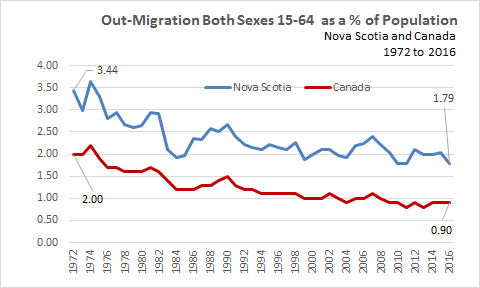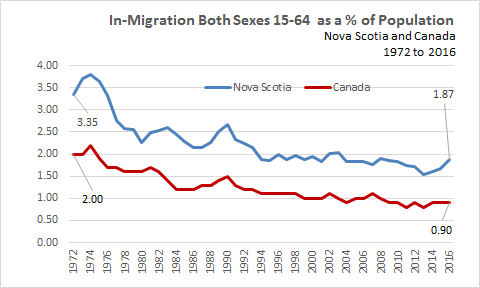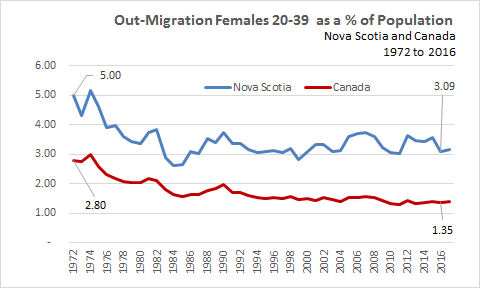The Economics and Statistics Division maintains archives of previous publications for accountability purposes, but makes no updates to keep these documents current with the latest data revisions from Statistics Canada. As a result, information in older documents may not be accurate. Please exercise caution when referring to older documents. For the latest information and historical data, please contact the individual listed to the right.
<--- Return to Archive
For additional information relating to this article, please contact:
November 20, 2017STUDY: BARRIERS TO LABOUR MOBILITY IN CANADA Recently, Statistics Canada released an analytical paper based on 2016 General Social Survey. The paper states that working-age out-migration population as a percentage of working-age population has declined from about 2% to about 1% over the period 1972-2016. But is this a major impediment to labour mobility?
What the 2016 GSS Revealed
Inter-provincial mobility
In the survey, of unemployed individuals aged 15-64 who were not students, 32% reported no barriers to interprovincial mobility. Almost 50% had personal reasons why mobility was restricted (to stay close to relatives, friends; spouse/children would not move; etc.). About 11% reported that moving would be too demanding, too expensive, not financially feasible. Less than 1% stated that their credentials would not be recognized elsewhere. The remaining 6% did not know or had other reasons.
Intra-provincial mobility
In the survey, of unemployed individuals aged 15-64 who were not students, 43% reported no barriers to interprovincial mobility. Almost 36% had personal reasons why mobility was restricted (to stay close to relatives, friends; spouse/children would not move; etc.). About 15% reported that moving would be too demanding, too expensive, not financially feasible. Less than 1% stated that their credentials would not be recognized elsewhere. The remaining 6% did not know or had other reasons.
Overall Conclusions
The majority of unemployed individuals are reluctant to accept a job offer in another province, or in another city within their home province for personal reasons (desire to remain close to friends and relatives, wishes of spouse or children). Therefore, family considerations play an important role in labour mobility.
Other Findings
At the provincial level the trend in diminishing migration as a percentage of population did occiur, but there are differences in scale, impact and volatility.
Difference in Scale
Between 1972 and 2016 working-age out-migration as a percentage of working-age population in Nova Scotia declined from about 3.5% to 1.8% over the period, while the national percentage declined from 2% to 1%. The scale in Nova Scotia is about double that of the national average.
The article reports that a similar drop in the percentage of out-migration was experienced by males aged 35-39: from 2.3% to 1.0%. Again, the decline in Nova Scotia was similar, but the scale of out-migration was typically double that at the national level.
In the national case, the percent reduction of out-migration of the working-age population may indicate the presence of a trade barrier to labour mobility in Canada.
With respect to Nova Scotia, the same decline in inter-provincial labour mobility has occurred, except the impact has been more pronounced.

In-migration vs Out-migration
Migration is a two-way street, with workers coming and going. Does the data reveal and difference between changes in in-migration and out-migration? According to the charting over the period 1972 and 2016, in-migration and out-migration demonstrate similar profiles. The percentage of working-age population migrating to another province is declining, and the magnitudes are also similar.

Migration of 20-39 year olds
Selection of the age range is an important factor. While a narrow 35-39 years age range does reveal a different pattern, migration at a lower age range reveals that after 1984, the year-over-year volatility is more pronounced but the annual percentage change remains flat; at about 3.5% for Nova Scotia and 1.5% for Canada.

A similar pattern is realed for males aged 20-39, and also for females.


Source: CANSIM 051-0001 | 051-0012
STC Daily: November 17 | The research article, STC Cat. No. 11-626-X, Barriers to Labour Mobility in Canada: Survey-based Evidence
<--- Return to Archive